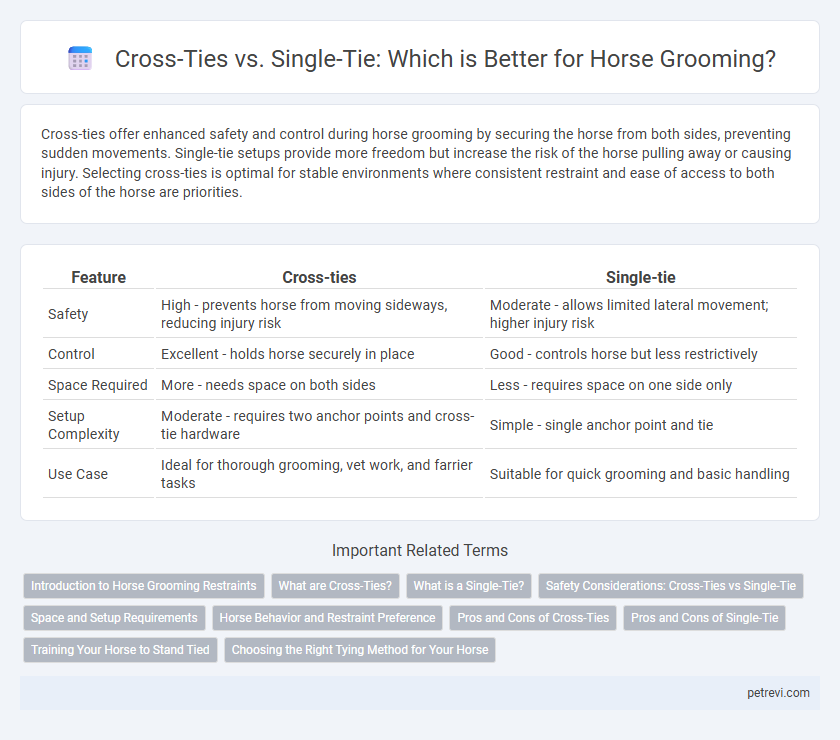Cross-ties offer enhanced safety and control during horse grooming by securing the horse from both sides, preventing sudden movements. Single-tie setups provide more freedom but increase the risk of the horse pulling away or causing injury. Selecting cross-ties is optimal for stable environments where consistent restraint and ease of access to both sides of the horse are priorities.
Table of Comparison
| Feature | Cross-ties | Single-tie |
|---|---|---|
| Safety | High - prevents horse from moving sideways, reducing injury risk | Moderate - allows limited lateral movement; higher injury risk |
| Control | Excellent - holds horse securely in place | Good - controls horse but less restrictively |
| Space Required | More - needs space on both sides | Less - requires space on one side only |
| Setup Complexity | Moderate - requires two anchor points and cross-tie hardware | Simple - single anchor point and tie |
| Use Case | Ideal for thorough grooming, vet work, and farrier tasks | Suitable for quick grooming and basic handling |
Introduction to Horse Grooming Restraints
Cross-ties provide stable, hands-free restraint by securing both sides of a horse's halter, minimizing movement during grooming and enhancing safety for both horse and handler. Single-ties attach the halter at one point, allowing more freedom but requiring careful monitoring to prevent injuries or escape attempts. Selecting the appropriate grooming restraint depends on the horse's temperament, grooming activities, and the handler's experience to ensure efficient and safe care.
What are Cross-Ties?
Cross-ties are a pair of ropes or straps attached on either side of a grooming area to secure a horse by its halter, restricting lateral movement and enhancing safety during grooming. They provide balanced restraint, allowing the horse to stand comfortably without turning or wandering off, which is essential for tasks like brushing, hoof picking, and tacking up. Cross-ties are commonly used in barns and wash racks for efficient and controlled horse handling.
What is a Single-Tie?
A single-tie for horse grooming is a secure attachment point used to fasten a horse by one side, allowing limited movement while maintaining control during grooming sessions. Unlike cross-ties that restrain horses from both sides, single-ties are often used in smaller spaces or for quick grooming tasks. This method minimizes stress for some horses and facilitates easier access to specific areas for cleaning and care.
Safety Considerations: Cross-Ties vs Single-Tie
Cross-ties distribute pressure evenly across a horse's head, minimizing the risk of injury by preventing sudden movements that could cause the animal to pull back abruptly. Single-ties concentrate force on one side, increasing the chance of neck strain or the halter slipping, which can compromise safety during grooming. Choosing cross-ties enhances control and reduces stress-related accidents, making them a safer option for securing horses.
Space and Setup Requirements
Cross-ties require a stable setup with two anchor points on opposite walls, maximizing safety and restraint but necessitating more space compared to single-tie setups. Single-ties attach to a single point, offering greater flexibility with limited space but less control over the horse's movement during grooming. Choosing between cross-ties and single-tie systems depends largely on the available grooming area and the need for effective restraint.
Horse Behavior and Restraint Preference
Cross-ties provide a balanced restraint that minimizes a horse's lateral movement, reducing stress and promoting calm behavior during grooming. Single-tie methods allow more freedom but may increase the risk of sudden movements, often requiring a more responsive handler to maintain control. Horses accustomed to cross-ties typically exhibit better compliance and safety for both the animal and groomer during grooming sessions.
Pros and Cons of Cross-Ties
Cross-ties provide greater safety by restricting a horse's lateral movement during grooming, reducing the risk of sudden lunges or kicks, and allowing handlers to work on both sides simultaneously. They require sturdy, well-installed anchor points and can cause stress or panic in horses sensitive to confinement, potentially leading to injury. Cross-ties improve convenience for professional grooming but demand proper training and supervision to ensure the horse's comfort and safety.
Pros and Cons of Single-Tie
Single-tie grooming offers greater freedom of movement for horses, reducing stress and potential injury during grooming sessions. However, it may not provide adequate restraint, increasing the risk of the horse moving suddenly and causing accidents. This method is best suited for calm, well-trained horses but may not be ideal for more energetic or anxious animals during grooming.
Training Your Horse to Stand Tied
Training your horse to stand tied begins with familiarizing it to both cross-ties and single-tie setups, helping build confidence and patience. Cross-ties provide stability by limiting lateral movement, reducing the risk of injury during grooming, while single-ties encourage more freedom, allowing the horse to adjust and learn restraint. Consistent, calm training using clear cues and positive reinforcement is essential for ensuring your horse remains safe and cooperative when tied.
Choosing the Right Tying Method for Your Horse
Cross-ties provide increased safety and control by securing a horse from both sides, minimizing movement during grooming and reducing the risk of injury. Single-ties offer simplicity and are ideal for quick tasks or horses that are calm and well-trained, but they allow more lateral movement, which can lead to potential hazards. Selecting the appropriate tying method depends on the horse's temperament, the grooming activity's duration, and the handler's ability to maintain safety and comfort throughout the process.
Cross-ties vs Single-tie for Horse Grooming Infographic

 petrevi.com
petrevi.com